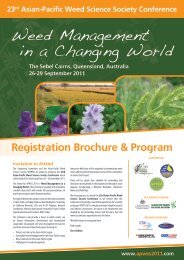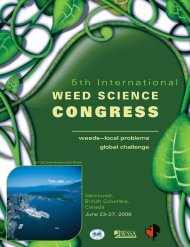PARAQUAT
PARAQUAT
PARAQUAT
Create successful ePaper yourself
Turn your PDF publications into a flip-book with our unique Google optimized e-Paper software.
Country<br />
El Salvador<br />
Nicaragua<br />
Costa Rica<br />
Costa Rica<br />
Date<br />
1998-00<br />
199-00<br />
1980-86<br />
1992-98<br />
No.<br />
923<br />
570<br />
749<br />
835<br />
Deaths<br />
94<br />
?<br />
257<br />
477<br />
Data in Table 1 is taken from Wesseling et al<br />
(2001a). Many of the incidents in the table are<br />
suicidal poisoning. In Costa Rica 1980-86,<br />
for example, 75% were unintentional, mostly<br />
accidental ingestion but also occupational<br />
exposure.<br />
4. Environmental Effects<br />
Paraquat is described by US EPA (2009) as<br />
“extremely biologically active and toxic to plants<br />
and animals”.<br />
4.1 Aquatic toxicity<br />
The Environmental Risk Management Authority<br />
of New Zealand described paraquat as “very<br />
ecotoxic to the aquatic environment” (ERMANZ<br />
undated).<br />
Fish<br />
US EPA (2009) classifi es paraquat as “slightly<br />
toxic” to freshwater fi sh, the 96 hr LC 50<br />
varying with species from 13 to 156 mg/L. At<br />
a concentration of 500 µg/L, which is below<br />
the recommended application rate, paraquat<br />
adversely affects sensitive species of freshwater<br />
carp (Eisler 1990).<br />
Acute toxicity – LC 50 (96 hr):<br />
• Rainbow trout = 19 mg/L (FAO 2008)<br />
• Mirror carp = 98 mg/L (FAO 2008)<br />
• Bluegill sunfi sh = 13 mg/L (US EPA 2009)<br />
Chronic toxicity – NOEC:<br />
• Rainbow trout = 8.5 mg/L (FAO 2008)<br />
Acute effects of paraquat on fi sh include<br />
abnormal stress behaviour such as excessive<br />
gulping of air, erratic swimming, restlessness,<br />
loss of movement, loss of equilibrium, increased<br />
beating of the fl ap covering the gills, excessive<br />
secretion of mucus, swimming on the back, and<br />
paralysis (Omitoyin et al 2006).<br />
Sublethal effects on fi sh include adverse<br />
effects on the immune system, with the effect<br />
enhanced by elevated temperatures (Salazar-<br />
Lugo et al 2009); alterations to gonads likely<br />
to affect reproductive activity particularly in<br />
males (Figueiredo-Fernandes et al 2006); and<br />
oxidative stress (Stephensen et al 2002).<br />
Paraquat-induced teratogenic malformations<br />
have been reported in the embryos of Oryzias<br />
latipes (Medaka or Japanese killifish) (Dial &<br />
Bauer Dial 1987).<br />
Amphibia<br />
At a concentration of 500 µg/L, which is below<br />
the recommended application rate, paraquat<br />
adversely affects frog tadpoles (Eisler 1990).<br />
As reported in the section on Toxicology, several<br />
studies have shown paraquat to be embryotoxic<br />
and teratogenic to frogs. Maternal exposure<br />
results in higher embryo and tadpole mortality,<br />
as well as growth retardation, abnormal tail<br />
fl exure and gut coiling, and stunted growth rate<br />
in surviving tadpoles (Vismara et al 2000, 2001a,<br />
2001b; Osano et al 2002), prompting Vismara<br />
et al (2000) to describe paraquat as highly<br />
embryotoxic for amphibia, and Osano et al to<br />
conclude that paraquat should be classifi ed as<br />
a teratogen. Dial & Bauer (1984) also reported<br />
teratogenic effects in young developing Rana<br />
pipiens tadpoles after treatment, at paraquat<br />
concentrations as low as 0.5 mg/L.<br />
Mussi & Calcaterra (2010) found that exposure<br />
to paraquat reduced the ability of embryos<br />
of the toad Chaunus arenarum to develop<br />
normally, leading to arrested development and<br />
severe malformations such as tail abnormalities,<br />
abdominal edema, reduced head development,<br />
and curved dorsal structures.<br />
Paraquat inhibited the production of testosterone<br />
in the testis and 17beta-oestradiol in the ovary of<br />
the frog Rana esculenta (Quassinti et al 2009).<br />
In a study in which tadpoles of the Rio Grande<br />
Leopard frog (Rana berlandieri) were fed plants<br />
with ‘fi eld-level’ residues of paraquat absorbed<br />
from water, the following effects were reported:<br />
signifi cant mortality, abnormal tails (fl exed or<br />
29




